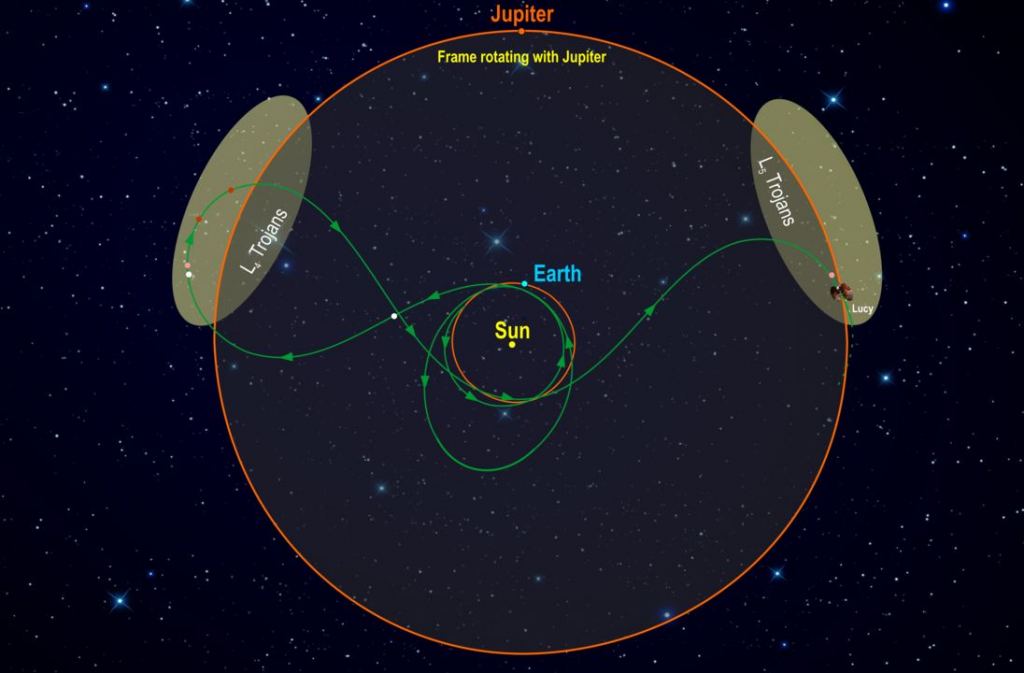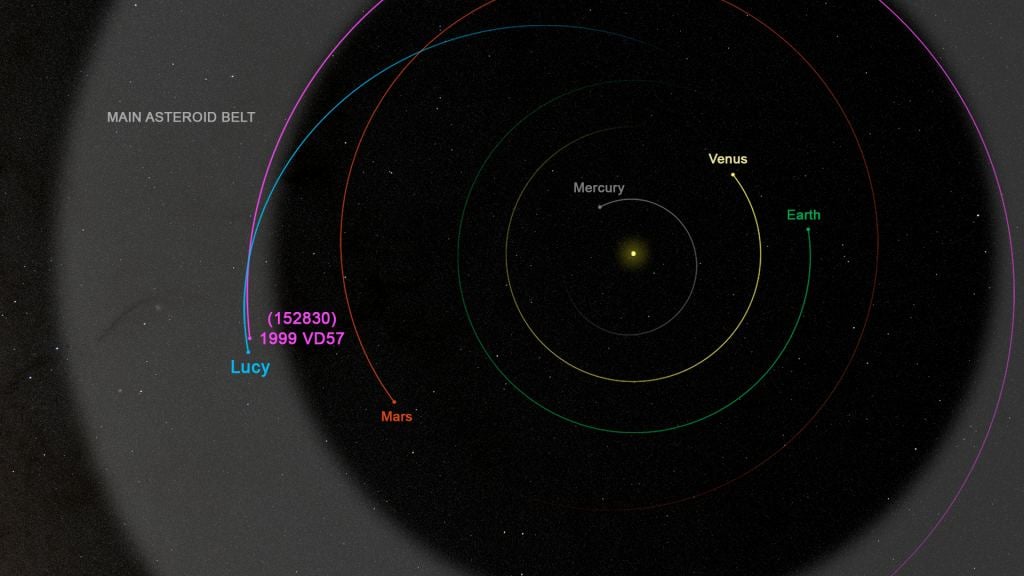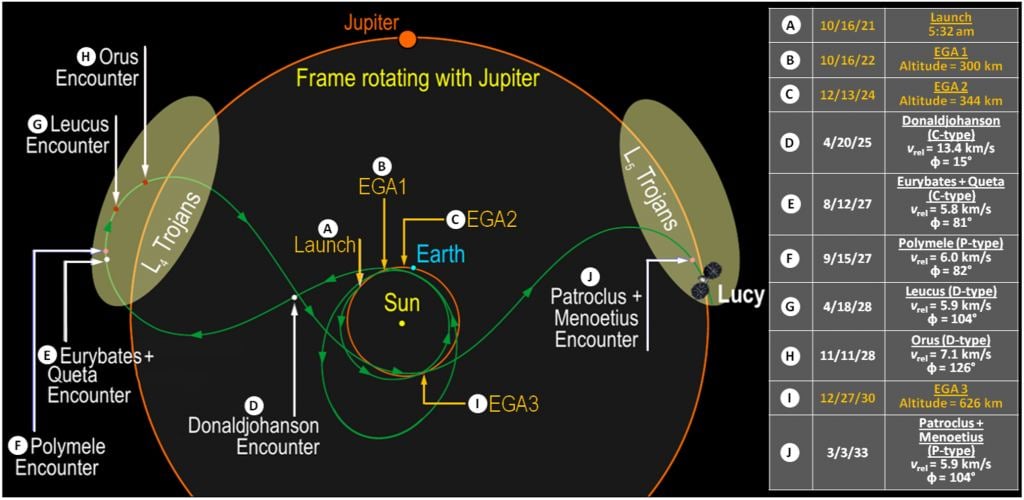In October 2021, NASA launched its ambitious Lucy mission. Its targets are asteroids, two in the main belt and eight Jupiter trojans, which orbit the Sun in the same path as Jupiter. The mission is named after early hominin fossils (Australopithecus afarensis,) and the name pays homage to the idea that asteroids are fossils from the Solar System's early days of planet formation.
Visiting ten asteroids in one mission is the definition of ambitious, and now NASA is adding an eleventh.
Astronomers sometimes refer to asteroids as fossils because they're remnants from the Solar System's early days when the planets were forming. Their status makes them important objects in piecing together the history of the Solar System. One type of asteroid, called Rubble-pile asteroids, can be over four billion years old.
Astronomers are eager to learn more about asteroids, and while chunks that fall to Earth are helpful, they have limitations. In recent years, two separate missions have visited asteroids and gathered samples: Japan's Hayabusa 2 returned samples from asteroid Ryugu in December 2020, and NASA's OSIRIS-REx mission will return samples from asteroid Bennu in September 2023.
Lucy won't be bringing any samples home, but it'll be observing 10 different asteroids in detail during separate flybys. The spacecraft has one of the most complicated paths of any mission. A detailed itinerary is necessary for the spacecraft to visit two groups of Jupiter's Trojan asteroids.
But now NASA has added another asteroid to Lucy's busy itinerary. It won't need to alter its course to visit this one. Instead, it presents itself as a target of opportunity in the main asteroid belt.
All of Lucy's targets are in constant motion, and combining Earth flybys with visits to separate groups of asteroids is daunting. Other spacecraft have visited multiple objects with flybys, but none have ever attempted to visit as many as Lucy is. Visiting all these asteroids requires a sophisticated, asteroid-tracking navigation system.
"There are two ways to navigate a mission like Lucy," said Jacob Englander, the optimization technical lead for the Lucy mission. "You can either burn an enormous amount of propellant and zig-zag your way around trying to find more targets, or you can look for an opportunity where they just all happen to line up perfectly."
Mission designers have calculated where all of Lucy's targets will be years in advance, but that doesn't mean it isn't complicated. Optical navigation is still necessary when Lucy approaches one of its targets. Camera images are combined with tracking data to determine the spacecraft's exact position.
That's where the additional visit to another asteroid comes in.
The asteroid is in the inner main belt and is designated (152830) 1999 VD57. It's a target of opportunity that will allow mission operators to test Lucy's navigation system before it visits its scientific targets.
"There are millions of asteroids in the main asteroid belt," said Raphael Marschall, Lucy collaborator at the Nice Observatory in France, who identified asteroid 1999 VD57 as an object of special interest for Lucy. "I selected 500,000 asteroids with well-defined orbits to see if Lucy might be travelling close enough to get a good look at any of them, even from a distance. This asteroid really stood out. Lucy's trajectory as originally designed will take it within 40,000 miles of the asteroid, at least three times closer than the next closest asteroid."
If a large, propellant-intensive maneuver was needed to visit the new asteroid, NASA wouldn't have considered it. But that's not the case. It can be added with only a small maneuver.
It's being added because of its value as an engineering test, according to NASA. And it'll address an issue that's particular to visiting smaller, rapidly moving objects like asteroids: as a spacecraft approaches one, it's difficult to determine the spacecraft's exact position in relation to the asteroid. That makes it difficult to know where to point its cameras.
"In the past, most flyby missions have accounted for this uncertainty by taking a lot of images of the region where the asteroid might be, meaning low efficiency and lots of images of blank space," said Hal Levison, Lucy's principal investigator from the Southwest Research Institute Boulder, Colorado office. "Lucy will be the first flyby mission to employ this innovative and complex system to automatically track the asteroid during the encounter. This novel system will allow the team to take many more images of the target."
Tracking the asteroid during the encounter rather than relying on pre-existing images is not without risk. But because of 1999 VD57's orientation, Lucy's flyby of the asteroid can serve as a dress rehearsal for its innovative way of navigating. The geometry of the encounter is similar enough to the spacecraft's eventual flybys of the Trojan asteroids that NASA can practice for its rendezvous with its scientific targets.
The asteroid is small and was never considered a target when NASA was designing the Lucy mission. It's only about 700 metres (0.4 miles) in diameter. It'll be the smallest main-belt asteroid ever visited. It's closer in size to Bennu and Ryugu, the near-Earth asteroids that were visited and sampled in recent years.
Lucy's original trajectory would've taken it to within 64,000 km (40,000 miles) of the small asteroid. But the new trajectory will bring it to within 450 km (280 miles) of the target.
The Jupiter Trojans are interesting targets because they're different than main-belt asteroids. Their surfaces are dark and reflect little light. They've been trapped in Jupiter's orbit for billions of years. While they're called asteroids, a paper outlining Lucy's science objectives refers to them as planetesimal from the outer Solar System. According to that paper, "They may have originally formed far beyond their current home (at ?15–30 au) and were transported to their current locations by early orbital evolution of the giant planet orbits."
Main-belt asteroids are not as old and are not pristine. They've been subjected to space weathering, heating, and collisions. They're interesting scientific targets for different reasons.
But the Trojan asteroids haven't been subjected to the same forces and are preserved primordial objects from our Solar System's early days. Within the Trojan asteroids, there are different taxonomic types, and Lucy will visit representatives of the different types, including a collisional family member and a near equal-mass binary. Its targets range from about 1km in diameter to 100 km in diameter.
We've only visited eight main-belt asteroids so far, and those visits revolutionized our understanding of both the asteroid belt and planetary formation in the Solar System. The Jupiter Trojans are unvisited, and Lucy will visit eight of them in one mission. They're a reservoir of early Solar System objects that practically beg to be explored and were serendipitously brought into reach by the migrations of the giant planets.
In May 2023, Lucy will start a series of maneuvers that will bring it close to its new target. Hopefully, this late addition to Lucy's itinerary will make their exploration more fruitful.
 Universe Today
Universe Today



